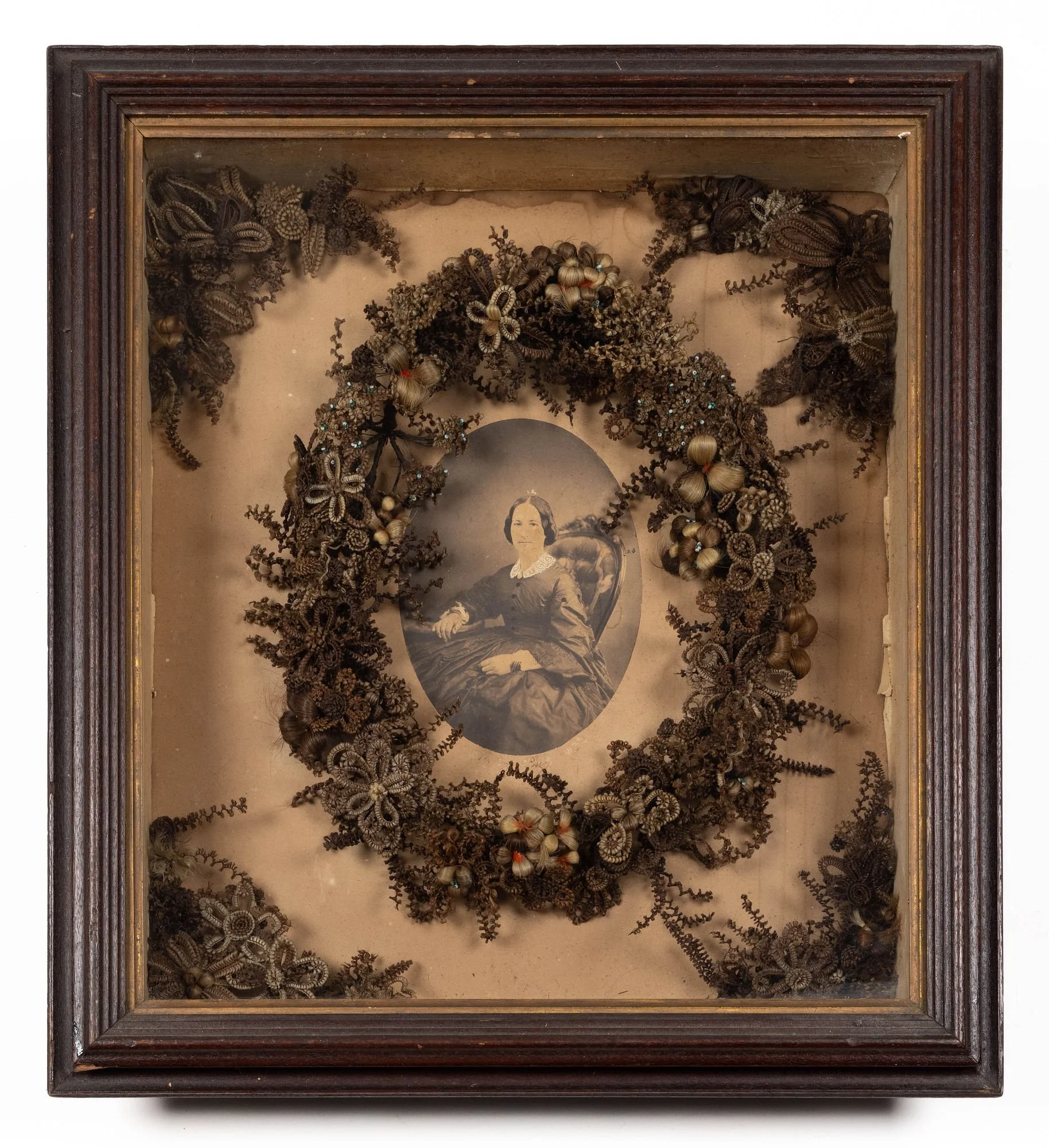A Delicate Thread: Victorian Hairwork, Wirework Hair Flowers, and the Craft of Sentiment
A Delicate Thread: Victorian Hairwork, Wirework Hair Flowers, and the Craft of Sentiment
by Diane Irby
In the refined parlors of Victorian homes, strands of human hair, preserved as tokens of affection, were transformed into elaborate blooms. Wrought with fine wire and infinite patience, women shaped hair into roses, lilies, and forget-me-nots; each petal, looped and woven from the very fiber of the human self, was crafted with meticulous care and transformed into vessels of memory, expressions of endearment, and whispers of loss. These wirework hair flowers were more than mere crafts or parlor decorations. They were gestures of remembrance, and of love held fast against the fading grip of time.
Emerging from long-standing European traditions, the art of hairwork found fertile ground during the Victorian era, a time when the language of sentimentality was woven into the fabric of everyday life. The practice of crafting hair into floral forms blossomed throughout the mid- to late-19th century, reflecting a culture that embraced domestic crafts as both a proper occupation and a form of expression.
Photograph of Victorian hair wreath, source unknown. Used for educational purposes under fair use.
As millions emigrated from Europe to the United States, they brought these customs with them: traditions passed down in memory, practice, and the quiet labor of women's hands. Settled into the rhythm of domestic life, the art of wirework hair flowers was practiced by women in parlors and sitting rooms, where sculptures and wreaths, composed of hair from both living and deceased loved ones, were displayed proudly. Unlike popular hairwork jewelry, which was often created in professional studios, wirework hair flowers were overwhelmingly handmade, preserved as precious heirlooms rather than sold as luxury goods.
The making of wirework hair flowers demanded delicate skill. Hair was carefully collected and sorted, then painstakingly looped and sculpted between twists of wire, often accented with beads. Yet, despite the intricate artistry involved, few instructional guides existed for those practicing wirework hairwork techniques. In contrast to the numerous manuals devoted to other forms of hairwork, such as table braiding and palette work, just two notable 19th-century publications - Art Recreations and Lady’s Fancy Work - offer only cursory and vague glimpses into the technique, suggesting that much knowledge was passed down through hands-on instruction, observation, and patient perseverance.
While often linked to mourning customs, these floral assemblages also celebrated life itself. They commemorated bonds unbroken by death, marking marriages, births, and family legacies. Each wreath might cradle the hair of several generations, weaving a tapestry of continuity and love through the language of flowers: roses for passion, lilies for purity, forget-me-nots for remembrance.
By the early 20th century, the practice declined. Industrialization, changes in fashion, and evolving social and mourning customs rendered hairwork passé, its sentimentality replaced by modern modes of memorialization. Yet some of these floral relics remain, fragile survivors housed in museums, antique shops, and private collections. Today, artists, historians, and descendants of the craft’s original makers are once again turning to these objects with curiosity and care. In their intricate forms, we find not only aesthetic complexity, but a tender insistence that memory may be shaped, strand by strand, into enduring form.
Further Reading
Urbino, L. R., and Henry Day. Art Recreations. Boston: J.E. Tilton & Co., 1863.
Jones, C. S., and Henry T. Williams. Ladies' Fancy Work: Hints and Helps to Home Taste and Recreations. New York: H.T. Williams, 1876.
The Language of Flowers; with a Complete Vocabulary, and a New Selection of Quotations from the English Poets, Illustrating the Sentiment and Meaning Attached to the Various Flowers and Plants... London: Ward, Lock and Tyler, 1877.
© Diane Irby. All rights reserved.
This article is the intellectual property of the author and may not be reproduced, republished, or distributed without permission. However, it may be cited for academic or scholarly purposes with proper attribution.
Citation:
Diane Irby, “A Delicate Thread: Victorian Hairwork, Wirework Hair Flowers, and the Craft of Sentiment,” Victorian Hairwork (victorianhairwork.art), last modified July 8, 2025, https://www.victorianhairwork.art/journal-research/a-delicate-thread-victorian-hairwork-wirework-hair-flowers-and-the-craft-of-sentiment.
